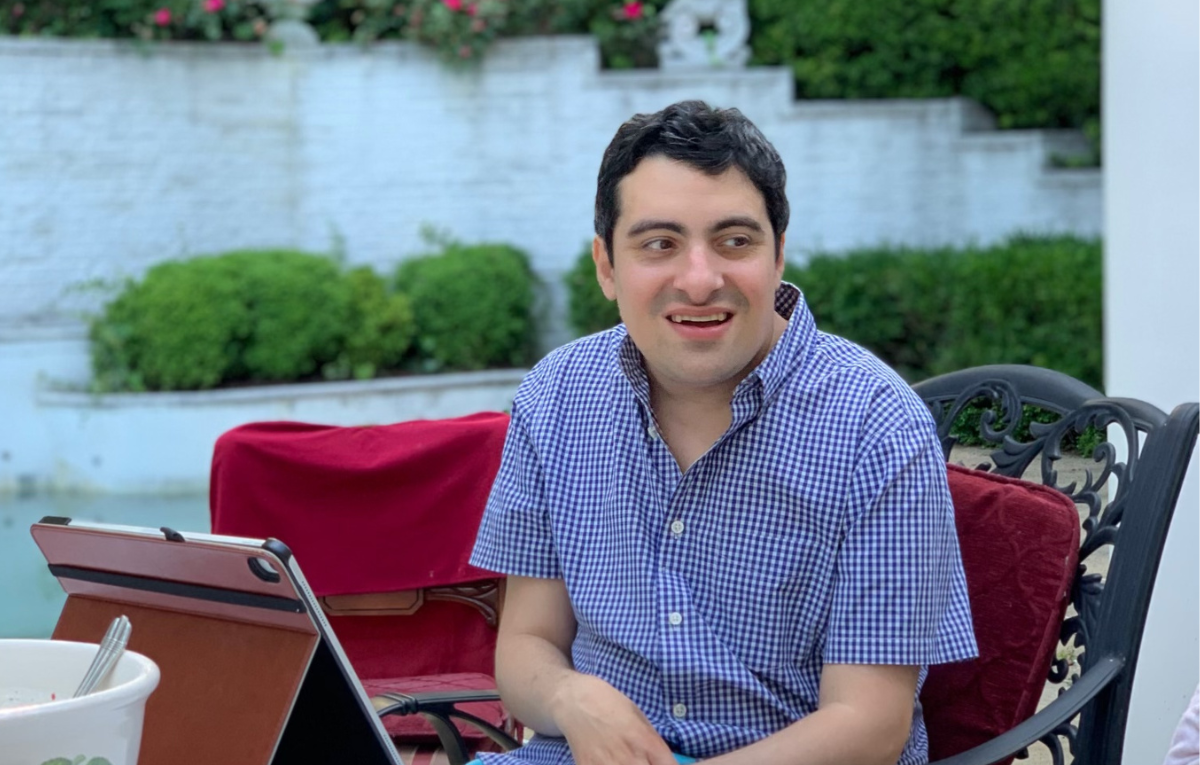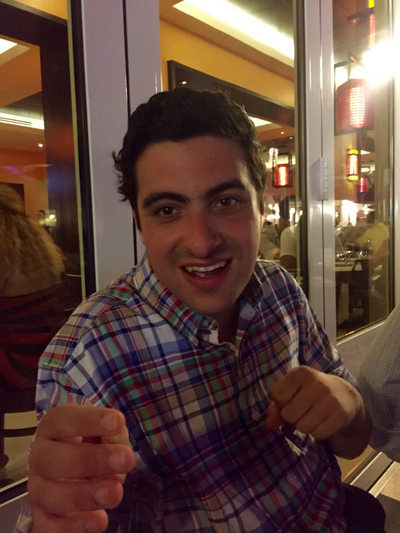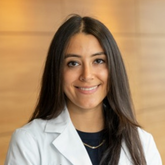How to Provide the Best Care for Patients with Intellectual and Developmental Disabilities (IDDs)

Everyone has a story behind their reason for going into medicine. Mine involves my cousin Amir (pictured above), who has an intellectual and developmental disability (IDD). Our close relationship, involving a shared love of books and music, and endless time together has fostered my sense of compassion and creativity. He continues to influence my passion for the field and work in developing inclusive curricula for other medical students.
If unfamiliar with IDDs, they are differences typically present at birth, which uniquely affect one’s physical, intellectual, and/or emotional development. They can affect multiple systems and body parts. Examples of IDDs include cerebral palsy, Down Syndrome, autism spectrum disorders (ASDs), and more.
[IDDs] are differences typically present at birth, which uniquely affect one’s physical, intellectual, and/or emotional development.
Unique Challenges With IDDs
Though Amir has been an incredible source of light in our family, life with any kind of disability has its challenges. It’s clear when Amir is frustrated, but it’s sometimes tricky to pinpoint what exactly is bothering him. When he’s sick, it’s hard to tell what hurts the most. Throughout my life, I’ve witnessed clinicians who have difficulty caring for him.
A number of recent surveys have demonstrated that physicians often cite a lack of training as a challenge in caring for those with IDDs. I think a great deal of this discomfort and lack of confidence stems from a lack of experience interacting with individuals with IDD. While out with Amir, I sometimes sensed people staring at us, some with underlying annoyance or pity.
Due to the lack of training in caring for patients with IDD, clinicians may have difficulty incorporating IDD patients into conventional practices.
Due to the lack of training in caring for patients with IDD, clinicians may have difficulty incorporating IDD patients into conventional practices. I knew that just one afternoon with Amir and my family would bring meaningful perspective to those who have not yet encountered an individual with a disability. Amir’s life is challenging in unique ways, but his positive energy and smile are contagious. If clinicians took the extra minute to find that smile, their days would be a bit brighter. When I discovered Operation House Call (OHC), run by the Arc of Massachusetts, I knew my idea could be executed.

A Solution to Educate Clinicians
During my first year of medical school, universal education on caring for individuals with disabilities was limited to a one-day interstitial course offered to 3rd-year medical students. This was concerning to me. I first learned of OHC while creating an optional elective centered on caring for pediatric patients with complex medical needs. It provided trainees with an opportunity to do a home visit with a patient with an IDD, and their families.
I redirected my efforts to ensure that all medical students, regardless of their field of interest, were equipped to encounter a patient with IDD.
At this time, I redirected my efforts to ensure that all medical students, regardless of their field of interest, were equipped to encounter a patient with IDD. I worked tirelessly to bring OHC to the 1st year UMass Medical School curriculum in 2022. It took lots of creativity, planning, presenting, hearing "no," leveraging relationships, and ultimately making the case to an on-campus department connected to a funder of interest. Finally, it was approved, and with lots of faculty support.
Hearing families discuss what day-to-day life looks like with a loved one with a disability can provide a newfound perspective to students and motivation to meet these patient encounters with more patience. Meeting these families in their homes, in a small group, encourages students to ask any questions they might have without the stress of appearing insensitive or awkward. In many ways, there need not be formal “training” on caring for individuals with disability—observation itself may do the trick. With some patience and creativity, caring for patients with IDDs is absolutely feasible and incredibly rewarding.
With some patience and creativity, caring for patients with IDDs is absolutely feasible and incredibly rewarding.
Whether or not you have encountered patients with IDDs in your practice, there’s a good chance that you will in the future, as approximately 6.5 million people in the US have one. With this in mind, there are several critical things to remember during your interactions (outlined below), which have been modified from OHC training materials.
Communicating with Patients with IDDs
- Always acknowledge the patient and speak directly to them whenever possible. Try to also work with parents, siblings, guardians, and caretakers present at the visit to find the best means of communicating if there are some barriers specific to this patient. (For instance, the patient may be non-verbal and use an alternate communication device.)
- Social difficulties in patients with autism can include a lack of eye contact. This doesn’t mean that the person isn’t listening or paying attention to what you are saying. Don’t give up on including them in the conversation.
- Incorporate the use of visuals and gestures. For example, you may provide a picture illustrating what will happen during the visit.
- Explain what you will do before starting any examination or procedure, so your patient knows what is coming next. Use whoever is there supporting them at this visit, or even yourself, to demonstrate what you are about to do.
- Try giving the patient choices. This increases independence and makes them feel more in control. (e.g., "We can look at your ears or your throat first; which would you like to do?")
- Assess patient understanding. You can ask the patient to repeat back information, ask it again, or use a fill-in-the-blank statement. (“A part of your body that hurts is ___.”)
Understanding and Accommodating Patient Behaviors
- Repetitive behaviors such as stimming (e.g., pacing, hand flapping, fidgeting, or rocking) can be used by people with IDDs as coping methods. Please respect them.
- The environment is key. Some patients may be light sensitive, sound sensitive, smell sensitive, or have any number of other sensory sensitivities.
- Learn about the patient's interests—and connect with them about those interests. For instance, even if you don’t share Amir’s love for books, horseback riding, or Chinese food, you can still connect with him about them.
Arranging Appointments
- Be flexible with standard office rules when possible. These individuals often need flexibility.
- Schedule appointments when the waiting time might be the shortest—such as first thing in the morning or right after returning from your lunch break.
- Ask about health care history and previous health care experiences.
Approaching Patients and Working with Families
- Think about how your unintentional implicit bias may affect the treatment and assessment of your patient. Especially important is to think of the patient in person-first terms. Don’t see them as just their disability.
- Be cognizant of and beware of diagnostic overshadowing. Many patients with ASD have undetected or undertreated medical conditions. Don't assume a new or challenging behavior is just "part of the syndrome" or "part of the autism.”
- Partner with family members or guardians. They might not be medical professionals, but they are the experts in their loved one’s day-to-day life.
Think of the patient in person-first terms. Don’t see them as just their disability.
Final Thoughts
Ultimately, my goal is to continue to share Amir’s story and to continue to give other patients with IDDs, and their families a voice.
Each time I return home and see my family, I take a moment to catch up with Amir and take a seat next to his pile of books. After flipping through a few pages with him, he always makes a point to ask, “Naaz, happy?” I am so incredibly happy. I am working towards the career I dreamed of while staying true to what brought me here in the first place. I am encouraged by the increased discourse surrounding this topic across medical schools and the progress we are making at UMass Chan Medical School.

Be the first to read articles from the field (and beyond), access new resources, and register for upcoming events.
SubscribeEdited by Melissa Baron. Clinical review by Andrew Esch, MD, MBA.
